Delphi Archaeological Museum
The Museum of Delphi is considered among the three most important museums in Greece, together with the ones of the Acropolis of Athens and in Heraklion, Crete. What makes a visit to the Greek Museums in general, this one in particular, an unforgettable experience, is the fact that they usually exist on the very archaeological site(s), thus putting the exhibits in the surroundings in which they were initially established, in close relevance to their cultural and/or religious role.
The Delphi Museum first opened its doors tο the public in 1903; in the more than 100 years that have elapsed since then, it has been recognized as one of the most important museums in Greece. It has undergone many renovations during this time and four different exhibitions, each reflecting the scientific concepts and artistic standards as they evolved through the 20th century. The quality of the exhibits, though, has always been the main advantage of this Museum.
According to Rosina Colonia, (Delphi Ephorate of Antiquities) “… the Delphi exhibits speak for themselves: they have the power to command respect and captivate the visitor, inviting him or her to admire them, and leaving this visitor with the memory of their charm and the enigma surrounding them. Even though the exhibits on display today constitute no more than a small but representative part of the dedications seen by Pausanias at Delphi, and an even smaller part of the many more that inundated the sanctuary during the years of its heyday, they indisputably continue to delight people with their wealth, variety and beauty. …Delphi has been included in archaeology textbooks, it has adorned art books; some of the Delphi finds, such as the Treasury of the Siphnians, are landmarks in the history of ancient Hellenic art, while others, even though more than one hundred years have elapsed since they came to light, continue to be a focal point of scholarly discussions even today, owing to unanswered questions regarding their identity and interpretation. But above all, they still chaim the broad public who flock, like ancient pilgrims, to admire the monuments of Delphi”. (Quotation ©: John S. Latsis Public Benefit Foundation)
Photos will be gradually added in the near future
Select Page of the Album:
Click on any of the pictures to enlarge.
The Glorious Temple (The Archaic Temple of Apollo - Hall VI)The Temple of Apollo in the 6th century BC.
The centrepiece of the sanctuary was the temple, abode of the god and seat of the oracle. In the 6th century BC, when the sanctuary's fame had spread throughout the entire known world, the temple had to have a form worthy of its ecumenical radiance. Consequently, after the fire in 548 BC, which destroyed the first stone temple of the sanctuary (which, according to the Homeric Hymn to Apollo, was founded by the god himself), work began on a much larger and grander edifice. The terrace on which the new temple was to stand was extended and a long retaining wall of polygonal blocks with curved joints was built to keep the bank of earth in place. The construction of the temple lasted many years and required a huge amount of money, which was raised through the generous contributions of Greek cities, colonies and foreign rulers. The new temple was associated with the Alcmaeonids, an aristocratic Athenian family that was living in exile during the tyranny of Peisistratus. The Amphictyony, which was responsible for administering the affairs of the sanctuary, entrusted the completion and decoration of the building to the Alcmaeonid family in 510 BC. In order to gain the favour of the god as well as the alliance of Greek cities in their struggle against political adversaries, Herodotus relates that the Alcmaeonids used marble for the temple facade, instead of poros (tufa) as stipulated in the contract. They also commissioned an eminent Athenian sculptor (possibly Antenor) to execute the sculptural decoration.
The result was indeed impressive, as evidenced by the two pedimental statues - of poros in the west pediment and of marble in the east - which were found during excavations. Despite their fragmentary condition, the statues enable us to identify the compositions which adorned the huge gables (height 2.35 m., width 19.40 m.). The ascetic grandeur of the sculptural themes and figures harmonises with the austere Doric order of the temple. In contrast with the lively movement of the west pediment depicting the Gigantomachy (battle between the Olympian gods and giants), the figures in the east pediment stand in «hieratic stillness», in awe of Apollo's arrival at Delphi.
The glory bestowed on the Alcmaeonids and the Athenians, whose mythical ancestors are depicted on the east pediment, was indeed magnificent, for their temple was extolled by great classical poets and admired by pilgrims to the Panhellenic sanctuary for over a century.
For in all cities the story of the citizens of Erechtheus (i.e. the Athenians) makes the rounds, Apollo, how they made your dwelling in divine Pytho (i.e. at Delphi)
a marvel to see.
(Pindar, Pythian for Megacles, vs. 9-13)
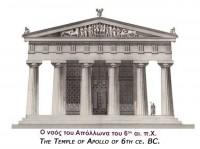
Reconstruction of the façade of the Archaic Temple of Apollo |
|

The east pediment of the archaic temple of Apollo, a work of Parian marble
The center of the east pediment, which was the most important, was occupied by Apollo’s four-horse chariot framed by Kouroi (young men) and Korai (young women). In both corners are animal groups depicting a lion mauling a domestic animal. The interpretation of the subject is based on verses fron Aeschylus’ drama “Eumenides”, in which the Pythia stands before the temple of Apollo and narrates the god’s arrival at Delphi from Athens. Apollo is seen off by the Athenians and greeted with great honors by the people of Delphi and their king, Delphos (510-500 B.C.)And thence he (Apollo) came unto this land of Parnassus
And at his side, with awe revering him, Were the children of Hephaestus (the Athenians), preparing the way
And taming the land that once was wildernessAnd he was received with honor
By all the people and Delphos, their king
|
|
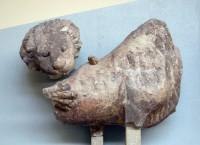
The east pediment of the archaic temple of Apollo, a work of Parian marble
The left corner of the pediment, with a lion attacking a domestic animal |
|
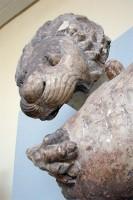
The east pediment of the archaic temple of Apollo, a work of Parian marble
The left corner of the pediment, with a lion attacking a domestic animal (Detail) |
|
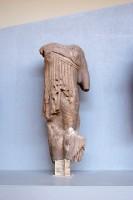
The east pediment of the archaic temple of Apollo, a work of Parian marble
A Kore representing the Athenian women accompanying Apollo in his journey from Athens to Delphi. Based on similarities with the Kore of Antenor (Athens Acropolis Museum), it is believed that it was the latter who sculpted this pediment. |
|
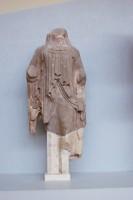
The east pediment of the archaic temple of Apollo, a work of Parian marble
Another Kore representing the Athenian women accompanying Apollo in his journey from Athens to Delphi. |
|
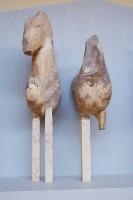
The east pediment of the archaic temple of Apollo, a work of Parian marble
Two of the horses of Apollo's chariot |
|
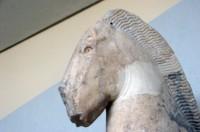
The east pediment of the archaic temple of Apollo, a work of Parian marble
The head of the first horse (Detail) |
|
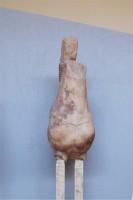
The east pediment of the archaic temple of Apollo, a work of Parian marble
And a third one |
|
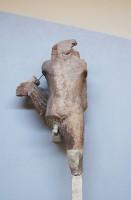
The east pediment of the archaic temple of Apollo, a work of Parian marble
One of the Kouroi accompanying Apollo |
|
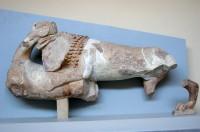
The east pediment of the archaic temple of Apollo, a work of Parian marble
The lion mauling its prey complex in the right corner of the pediment |
|
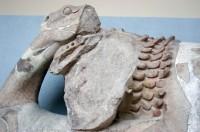
The east pediment of the archaic temple of Apollo, a work of Parian marble
The lion mauling its prey complex in the right corner of the pediment (Detail) |
|

The west pediment of the archaic temple of Apollo
...depicting the Gigantomachy (battle between the Olympian gods and Giants). From the left part of the composition the figures have been preserved of a giant on his knees (Enceladus?), Athena wearing a breastplate and charging, the lower part of a male figure (perhaps Dionysus) and fragments of two horses from Zeus' chariot which occupied the centre of the pediment. Traces of rich color decoration are preserved on the stuccoed poros figures (510-500 BC).
This is the pediment admired by the women of the chorus in Euripides' Ion: But also here in this temple
of divine Loxias {Apollo], son of Leto observe the battle of the Giants painted on the stone walls.
See there, where the goddess Athena stikes Enceladus and brandishes her openwork gorgon shield.
( Eur. Ion 190 et seq.) |
|
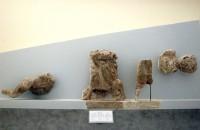
The west pediment of the archaic temple of Apollo
The whole complex of exhibits preserved from the west pediment of the archaic temple |
|
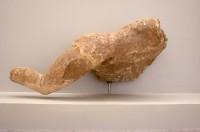
The west pediment of the archaic temple of Apollo
The bent figure to the left of the pediment, probably the Giant Encelados fallen on his knees |
|
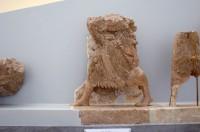
The west pediment of the archaic temple of Apollo
The bottom part of Athena's body and part of the body of Encelados and, to the right, of a male figure, maybe Dionysus |
|
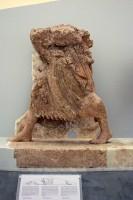
The west pediment of the archaic temple of Apollo
The bottom part of Athena's body (Detail) |
|
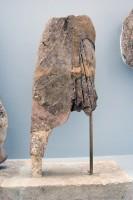
The west pediment of the archaic temple of Apollo
The bottom part of the body of a male figure, possibly the one of Dionysus |
|
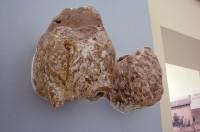
The west pediment of the archaic temple of Apollo
Remains of the sculptures in the central part of the pediment, probably of the two horses from the chariot of Zeus |
|
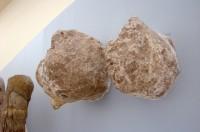
The west pediment of the archaic temple of Apollo
Remains of the sculptures in the central part of the pediment,, probably of the two horses from the chariot of Zeus |
|
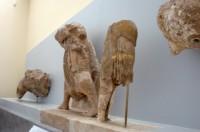
The west pediment of the archaic temple of Apollo
The remains of the left side of the pediment photographed from the right |
|
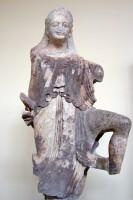
The decoration of the Archaic Temple: Winged Victory running
Marble 'akroterion' from the archaic temple of Apollo. It represents a winged Nike (Victory) in an iconographic convention suggesting that the figure is running. This conventional rendering of movement, along with the smile and the stepped folds of the himation, are typical of archaic sculpture. 515-505 B.C. |
|
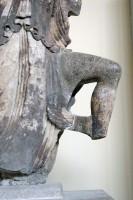
The decoration of the Archaic Temple: Winged Victory running
The winged sandals of the 'Winged Nike' |
|
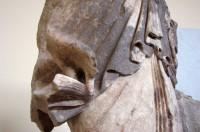
The decoration of the Archaic Temple: Winged Victory running
Part of Nike's 'himation' clothing |
|
Select Page of the Album:
|
|



